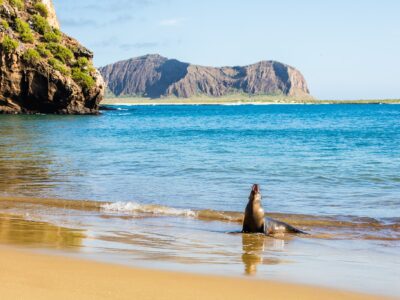Globally, concerned citizens have devised creative strategies for protecting glaciers in the face of climate change, with past campaigns ranging from covering glaciers with blankets to holding a funeral for a glacier. Efforts to protect glaciers from climate change are especially important in regions where glaciers are culturally important, like Iceland. This spring, Icelandic citizens took a new approach: nominating a glacier for president. The campaign did not earn the necessary number of signatures to place their candidate on the ballot, but members remain hopeful that the support gained can be channeled into other efforts to protect Iceland’s glaciers and ecosystems.

While using legislation, court rulings and ballot measures to provide natural features with legal rights is not new, these so-called “Rights of Nature” campaigns have become more common in recent years. They seek to provide natural features like rivers, ecosystems and glaciers with legal “personhood” to make it easier to protect them from pollution and climate change. As of 2024, many nations have followed this legal pathway, including Ecuador, New Zealand and the Yurok Tribe with many of these campaigns being led by local and Indigenous communities.
Rights of Nature campaigns can be controversial, especially as courts grapple with interpreting these new protections. In an interview with GlacierHub, Michael Gerrard, the director of the Columbia University Sabin Center for Climate Change Law, highlighted these drawbacks, saying, “there has been very limited practical impact of these [legal personhood] campaigns so far, despite a lot of discussion in academic and activist circles.”

The campaign that sought to nominate Snæfellsjökull, an Icelandic glacier, for president was the first attempt within Iceland to establish Rights of Nature. It differs from typical strategies like using legislation or court rulings, but the basis of establishing legal rights for natural features remains the same.
The idea for “Snæfellsjökull fyrir forseta” (“Snæfellsjökull for president”) came from Angela Rawlings, a Canadian-Icelandic artist who has had a deep connection to Snæfellsjökull for many years and who wanted to center glaciers and climate change in Iceland’s election. The campaign quickly picked up momentum and drew in a large group of activists, artists and other Icelanders.

“Geologists predict all glaciers in Iceland will disappear in the next 150 to 200 years,” Iris Valckx, a campaign spokesperson and environmental lawyer, emphasized in an interview with GlacierHub. “This is irreversible and highlights the need to shift from a global perspective of egocentrism to ecocentrism.”
As far as logistics went, the campaign argued that Snæfellsjökull met all the requirements of running for presidency under the Icelandic constitution: it was a de facto Icelander (having been there for centuries), was over 35 years old and had no criminal record. Rawlings lent her social security number to the glacier to resolve the issue of citizenship, taking “Snæfellsjökull” as her legal middle name.
The campaign highlighted Snæfellsjökull’s role in Icelandic heritage and environmental stewardship. It poked fun at common political slogans, with one post on their Instagram stating “Iceland needs transparent politics” over an image of ice. Snæfellsjökull even had international recognition as the fictional entrance point in Jules Verne’s 1864 novel “Journey to the Center of the Earth.”
All that was left to do was to collect the necessary 1,500 signatures to get on the ballot, which was not an easy task.
Snæfellsjökull’s presidential campaign looked different from most others. Stump speeches were replaced with visits to Snæfellsjökull, where attendees listened to the sounds of nature, the glacier and each other’s ideas. Marches were replaced by a “jökulskrið” (glacier crawl) where community members walked in slow motion, mimicking the slow flow of glacial ice. Members of the campaign worked hard to build a community and highlight the intrinsic relationship between Icelandic communities and glaciers like Snæfellsjökull.

Gísli Pálsson, a professor emeritus of anthropology at the University of Iceland, who was not involved with the initiative, told GlacierHub he thought the presidential campaign “was a great stunt, making people aware of the potential extinction of glaciers and the possibility of granting glaciers citizenship and personhood.”
Despite their efforts, Snæfellsjökull failed to garner the required signatures. However, both Valckx and another campaign spokesperson, Cody Skahan, remained enthusiastic. “We’ve built a community around this movement, which is something we can be proud of,” said Valckx.
“We’re focusing on how to incorporate discussion of Rights of Nature and glacier retreat into the ongoing presidential race through questions submitted for public debates, media articles and use of our creative outlets,” said Skahan, adding, “we’re also hoping to pivot to a more general Rights of Nature focus, incorporating different Icelandic ecosystems.”

This may be an uphill battle though, as according to Pálsson, environmental issues did not get as much traction as the Snæfellsjökull campaign may have hoped. “The ‘environment’ wasn’t really on the agenda, although several candidates referred to ‘gildi’ [values], including protecting Icelandic nature,” explained Pálsson. “I do think that [the campaign] is more of a performance than anything else, but as an environmental action, it may help to inform communities, particularly close to declining glaciers,” he added.
While Rights of Nature campaigns can be meaningful and powerful, experts on glacier activism like Mark Carey, a professor of geography and environmental studies at the University of Oregon, caution against campaigns that stop at awareness or performance. “Campaigns that focus on awareness for climate change and melting glaciers are outdated,” said Carey in an interview with GlacierHub. To move beyond awareness, he explained, the campaign should continue to work toward “legal and political actions that are formalized in binding ways to enact Rights of Nature,” which would serve as an “exciting” example if they can accomplish this.
Snæfellsjökull may not have won the Icelandic presidency, but it has sparked a new movement in Iceland to push for better protections for glaciers and ecosystems. Whether the campaign moves beyond awareness into meaningful change for the nation remains to be seen, but leaders seem hopeful and determined to achieve these protections, even without a glacier running the country.


